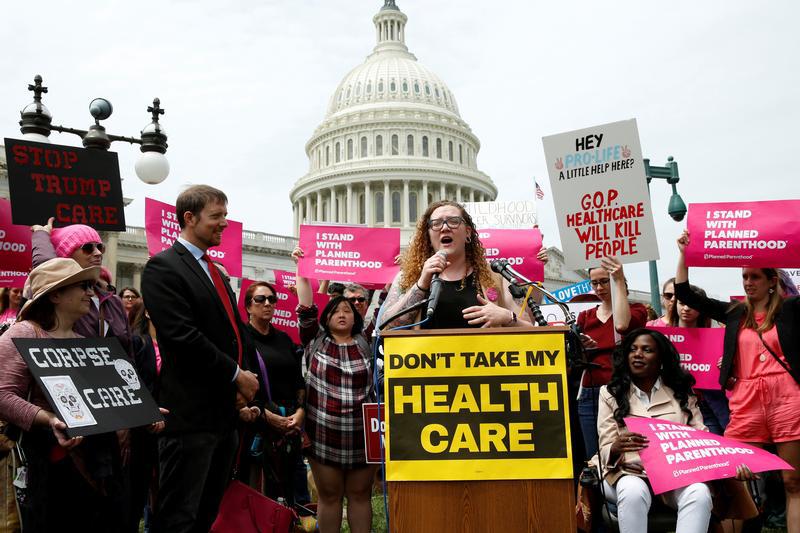
Protesters rally on Capitol Hill in Washington, D.C. during US House voting on the American Health Care Act, which would repeal major parts of the 2000 Affordable Care Act know as Obamacare, May 4, 2017.
Medicaid
One of the most important ways the ACA achieved success in insuring more people was by expanding Medicaid to cover people with incomes up to 137 percent of the federal poverty level, providing health coverage to an additional 14 million people in 31 states. The American Health Care Act would cut Medicaid by US$880 billion over 10 years, replacing the federal program with block grants to states and, beginning in 2020, setting caps on the amount of federal funding that could be spent per person. Medicaid expansion would be frozen for states that have already pursued it and phased out entirely by 2020.
Many states that expanded Medicaid under the ACA saw dramatic improvements in healthcare coverage for their residents. In Louisiana, for example, more than 400,000 people have gained health insurance coverage since July 2016 – more than 60 percent of them women.
Human Rights Watch spoke to one such woman in Louisana, “Jacquelyn.” She has endometriosis, a condition in which tissue that normally grows in the uterus grows outside it, for which she had to undergo surgery at a time she did not have insurance coverage. She made monthly payments to the hospital, then was able to go on the TV program Wheel of Fortune. She used her winnings to pay off the US$25,000 in medical bills.
It was not until July 2016, when Louisiana Governor John Bel Edwards expanded Medicaid, that she was fully insured and able to afford the health care she needed. She went to Planned Parenthood, where she now works, to have an IUD inserted to stop the daily bleeding that comes with endometriosis. She is also able to go to the dermatologist for preventative care that could be potentially life-saving, since she has a history of melanoma, which can be deadly.
“I am terrified that Congress will take away Medicaid expansion because most people on Medicaid are like me, what I call the poor middle class,” Jacquelyn said. “We are people who have student debt and medical debt and who work 40-50 hours a week to keep our heads above water.”
Insurance Coverage
The American Health Care Act changes the subsidy structure for purchase of private insurance under the ACA. The ACA based tax credits and subsidy amounts on income, age, and the local cost of insurance, while under the American Health Care Act, such assistance would be based only on age. This approach would result in less assistance for low income people, while benefits would increase for people with higher incomes.
“Monica,” 46, and her husband own a small business in Kenner, Louisiana. Prior to the ACA, she could not get insurance – either it was denied because she had a pre-existing condition, or was so expensive that she could not afford it. “Before the ACA, the only plans offered to me were more than US$1,000 a month,” she said. Currently, with the help of subsidies and tax credits provided for plans in the insurance exchange, she pays about US$300 a month for a “good plan” that covers her, her husband, and her daughter. She is very anxious about what would happen if the cost of insurance goes out of reach again. “It would be just devastating to my family,” she said.
Mental Health Care and Drug Dependence Treatment
In the US, approximately one in five adults has a mental health condition. But only half of people with mental health conditions are receiving treatment, and they are less likely to be insured than other people. The ACA attempted to address the situation by including mental heatlh and substance use treatment as a mandated essential health benefit for both private and public insurers. Under the American Health Care Act, states could opt out of this mandate, with potentially severe consequences for millions of people seeking treatment for mental and behavioral health problems.
“Deborah,” 49, who lives in Arizona, told Human Rights Watch what it had meant to her family to be without mental health coverage in their insurance plan prior to the ACA. When Deborah’s oldest son, Andrew, began having problems with addiction, her family’s insurance didn’t cover mental health care. He entered a rehab program in 2013, but Deborah and her husband had to pay US$10,000 up front for 30 days. That money would have gone to their mortgage payments. They didn’t make a payment for a year, and had to sell their house on a short sale in lieu of foreclosure. “We lost our home for medical care to save my son’s life,” she said.
In 2014, the family bought coverage under the ACA, and Andrew went back into rehab for a US$1,000 co-pay. “$1,000 vs $10,000 – that’s a huge difference,” she said.
Andrew died from an overdose in 2016, and Deborah wishes they had better mental health care coverage before the ACA. It would have meant better treatment and counseling for Andrew, she thinks. “How do you tell your child you can’t take them for care because you can’t afford it?”
While President Donald Trump has vowed that his administration will end the opioid epidemic, the American Health Care Act has the potential to worsen it. Rural America – particularly areas of Ohio, Kentucky, New Hampshire, and West Virginia – is already “ground zero” for the nation’s opioid crisis, and the House bill threatens to undermine progress being made on this issue.
By eliminating the requirement under the ACA to cover mental health care, including drug treatment services, both with private insurance and with Medicaid, the American Health Care Act would cause many people struggling with opioid dependence to lose access to treatment. In the 31 states that have expanded Medicaid, 1.2 million people who previously had no insurance have received drug treatment services.
Among them is Freddy, a 27-year-old from Tucson. When he first needed treatment for his heroin use, Arizona had not expanded Medicaid, and he had no health insurance. His parents paid out of pocket for him to enter a residential treatment center and ended up losing their home as they could no longer make the mortgage payments. “My parents had to choose between their house, or saving my life,” he said. He is now in outpatient treatment that is covered by Medicaid. He works at an airplane refurbishing company in the area and is in the process of recording a rock/funk album with his brother. “For once in my life,” he says, “I am actually happy!”
Women’s Health and Planned Parenthood
Medicaid is fundamental for women’s health in the US – covering roughly half of all births and 75 percent of public financing for family planning services, among other key women’s health services. Nearly half of low-income women in the US rely on Medicaid for health insurance, as do roughly one in three Black women, one in four Latina women, and one in five Asian and Pacific Islander women of reproductive age.
The bill’s ban on Medicaid reimbursements for Planned Parenthood services would also have devastating consequences. For more than 40 years, federal law has prevented Planned Parenthood, or any service provider, from receiving federal funding for abortion services, but the American Health Care Act targets the organization because it provides abortion care for women with non-federal money.
Planned Parenthood provides a broad range of services to women and men in some of the country’s most marginalized communities, including safe, non-judgmental services for victims of sexual violence; screening for cancer, diabetes and high blood pressure; vaccines; and other preventive health care.
More than half of Planned Parenthood’s clinics are in rural or urban areas that are designated by the federal government as “medically underserved.” In more than 100 counties throughout the country, Planned Parenthood clinics are the only providers of family planning services. Women like Jacquelyn would not be able to seek services at their preferred provider if the Senate adopted apunitive provision to ban Medicaid reimbursements to Planned Parenthood.
Nicole, a 25-year-old woman in Colorado, told Human Rights Watch that she usually seeks care at Planned Parenthood because she considers it compassionate in a way that other service providers are not. She was sexually assaulted one night after the Planned Parenthood clinic near where she lived closed. She couldn’t afford treatment in a private clinic because the deductible on the health insurance she had at work was too high. So she went to a hospital emergency room instead.
“I went to the hospital and saw a doctor and they made me feel like a slut,” she said. “I didn’t even want to tell them what happened, they were so mean about me just asking for a test. I felt alone and it was really bad.” She has since moved to an area where she has access to a Planned Parenthood clinic.
Older People
Contrary to the perception that only Medicare takes care of older people, Medicaid provides integral support to this growing demographic as well. For many of the 1.2 million older Americans who rely on institutional long-term care, almost two-thirds of them women, the median cost of one year in a nursing facility – US$90,000 – would be prohibitive without Medicaid contributions. Because Medicaid covers costs for a nursing facility stay beyond 100 days and for many community-based services, and provides support for people to remain at home, Medicaid cuts would make critical long-term care more difficult to obtain.
“Ken,” a 68-year-old former employee of a trucking company who has Parkinson’s disease, is in a nursing facility in Illinois. He moved there, far from his family, because he required more support and health care than he could obtain at home with the progression of his illness. Medicaid is “very important because that’s where I get the money to stay here,” he said. “I’m in a wheelchair all the time … nobody at home to take care of me. If I couldn’t stay here, I don’t know where I would be.” His access to essential health services and a safe living environment would be curtailed without access to Medicaid.
“Mark,” 65, lives in Hayward, California. Mark is diabetic, and in spring of this year, his right foot had to be amputated due to complications from a staph infection. With an income of US$1,500 a month in Social Security, he relies on Medicaid to pay for necessary institutional care and for the rehabilitation sessions that are teaching him “how to walk again and do things without the use of my right foot.” Mark said that Medicaid “was not important to me until I got sick. I think that’s the way it is with a lot of elders. They won’t know it is a problem until it’s too late.” Cuts to Medicaid would threaten Mark’s ability to live safely, with dignity, and as independently as possible.
People with Disabilities
For people with disabilities, who have a right to community-based care, the shrinkage of Medicaid could be devastating and force many into instutional settings. It would phase out federal matching funds that give states incentives to support home- and community-based services. Over the next decade, the American Health Care Act would cut 25 percent of Medicaid’s budget – shrinking a program that serves more than 10 million people with disabilities.
In its current form, Medicaid allows people with disabilities to receive at-home personal care services. Medicaid also allows them to have choices and control over their lives – deciding where, how, and with whom to live, and enabling them to carry out normal daily activities from getting up in the morning, bathing, preparing breakfast, and going to work or school.
For people like Alana Thierault, a 50-year-old woman from California with spinal muscular atrophy, loss of Medicaid coverage and funding support for her home-based assistance may result in the end of her ability to live independently. Her condition is a form of muscular dystrophy, a genetic neurological condition that causes muscles to become weak.
Medicaid covers the services of home care workers, who go to her house in the mornings and help her perform ordinary daily activities like bathing, getting dressed, and going to work. If she were to lose those services, she wouldn’t be able to lead an independent life and she would end up living in an institution.
Stacey Milbern, a 29-year-old woman with a disability living in Oakland, said that if Medicaid supports were cut, “I likely would be living in an acute care facility – it’s very much an institutional setting and not my own home.” Milbern is able to get 24-hour attendant and nursing services, including 40 hours a week of private duty nursing that takes care of the medical side of her disability. Other attendants help her get out of bed and drive her to work.
Jade Theriault, who also has spinal muscular atrophy, said that cutting Medicaid “would be like a slow stripping of my freedom.” She now lives in her own apartment and has a team of five or six assistants who each spend two-hour blocks throughout the day to help her with daily activities, including overnight care. She uses a respiratory equipment and her attendants also help to operate it. If Medicaid were cut she wouldn’t be able to pay for these services.
Pre-Existing Conditions
The American Health Care Act would eliminate much of the ACA’s protection for people with pre-existing conditions, creating instead “high risk pools” that experts say will not be adequately funded in this legislation. These provisions and cuts to Medicaid would harm millions of Americans with chronic illness. Sixty percent of people with HIV depend on Medicaid for their health care.
Before Louisiana expanded Medicaid, “Roberta,” a 47-year-old school bus driver, struggled with her HIV care. She had no health insurance and could not always afford her anti-retroviral medication. “Sometimes I had to buy my pills from people I knew who had extra, one pill at a time,” she said. Now with Medicaid coverage, she was able to get glasses, was diagnosed with a thyroid condition she didn’t know she had, and has not missed a dose of her HIV medication.
[“Source-ndtv”]










